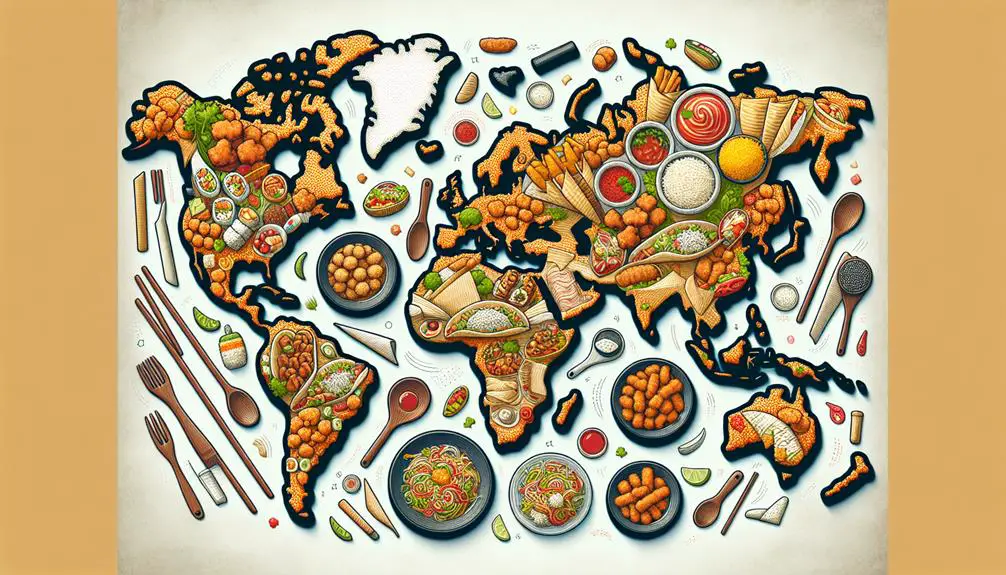Chicken fingers are a popular dish that many people enjoy. They have a mysterious origin, with different stories about where they first came from. Over time, they have become a favorite in restaurants all across the United States.
People have come up with different ways to make them, adding their own special flavors and coatings. These tasty strips of chicken have a fascinating history that continues to evolve, and they have definitely earned their place on the menu.
Origin of Chicken Fingers: Early Roots of Breaded Chicken

Breaded chicken dishes have a long history that started in Europe and influenced the Southern fried chicken traditions in America.
European recipes like schnitzel from Austria and the Italian milanesa were early versions of breaded meats, which paved the way for the crispy and delicious fried chicken we love today.
These dishes are simple but yummy: a tender piece of meat covered in breadcrumbs and fried just right.
This method has been used in many places, but it’s the American South that really made it their own.
They added their own spices and flavors, making it a comfort food favorite in the United States.
Just picture the Southern cooks of the past, trying out different seasonings to give their fried chicken that special taste.
And it’s not just about the flavor – there’s an art to getting the perfect crunch, a skill passed down through generations.
When you munch on chicken fingers, it’s not just a yummy snack; it’s a taste of history.
What started as a simple way to cook meat has turned into a variety of breaded chicken dishes, each with its own twist but all coming from the same roots.
Chicken fingers are a great example of how this cooking style has evolved, loved from fast food places to family dinners.
Emergence of Chicken Fingers in the U.S.

The chicken fingers we love today came from the U.S. when chefs changed traditional fried chicken into easy-to-eat strips.
The Puritan Backroom in Manchester, New Hampshire, says they invented chicken tenders in 1974, but Mussari’s Sun Valley Motel and Restaurant in Hazleton, Pennsylvania, advertised french-fried chicken fingers in 1966.
Spanky’s Pizza Galley & Saloon in Savannah, Georgia, and Guthrie’s in the Southeast also say they were the first chicken finger restaurants in America.
Chicken fingers became really popular in the 1980s and were loved as a snack, a main course, and even as drunk food.
They can be found in many places now and are simpler and milder compared to traditional fried chicken.
Chicken fingers have changed a lot and can now be grilled, covered in tasty sauces, and even made into plant-based versions.
But no matter how they’re made, chicken fingers are still a favorite part of American food.
Rise in Fast Food Culture

Fast food became really popular in the middle of the 1900s. Chicken fingers became super popular too and were on the menus of lots of new fast-food places.
You could get them at places like Raising Cane’s and Zaxby’s. They were crispy and yummy and perfect for when you needed a quick meal.
At these fast-food places, they made chicken fingers in different flavors like spicy Buffalo and sweet Honey BBQ.
They even had grilled ones for people who wanted something healthier. They were so popular that you could find them everywhere, and you could eat them in different ways like in a combo, in a sandwich, or on a salad.
They were always there for you when you needed a quick meal.
Fast food wasn’t just about being fast; it was also about making chicken fingers a big part of our culture.
They showed how America likes to come up with new things and make life easier, just like the fast-food places that served them.
Commercialization and Branding

Fast-food places quickly started selling chicken fingers with different flavors and cool names to stand out. They called them all kinds of things like tenders, strips, or nuggets to make them sound special.
Raising Cane’s Chicken Fingers became popular by focusing only on chicken fingers and their special sauce.
Chick-fil-A’s original chicken sandwich became really famous and people go crazy for their new stuff.
They made chicken fingers into a big deal through catchy slogans and fun social media stuff, not just because they taste good.
When you see signs for ‘Zaxby’s’ or ‘Popeyes,’ it’s not just about the chicken; it’s about the whole vibe.
Chicken fingers are now a big part of fast-food culture because of how they’ve been marketed and branded.
They made them a staple in the American diet by making them nostalgic and easy to get, and by offering lots of yummy dips.
Cultural Adaptations and Regional Variations

Have you ever noticed how chicken fingers have become a super popular food in family restaurants all over the United States, and each region puts its own special twist on them?
From one side of the country to the other, these crispy strips are loved by different cultures, making them as varied as the country itself.
In the South, they cover them in a tangy BBQ sauce that’s super yummy and reflects the region’s love for smoky flavors.
In the Southwest, they make them with a spicy breading that shows how much they like spicy food in that area.
And up in the Northeast, they often come with a side of creamy honey mustard, mixing the tasty and sweet flavors in a way that’s become a tradition there.
It’s not just about the sauces, though. The way they cook them can be different too, with some places using special local spices or herbs to make them extra tasty.
In the Midwest, they might serve them with mashed potatoes and gravy, turning a simple meal into a really comforting one.
Big family restaurants have helped make chicken fingers super popular, so they’re not just a fun treat for kids, but also a quick and satisfying option for parents.
You’ll see how they’re usually at the top of the kids’ menu, showing how much kids really like them.
Ingredients and Cooking Techniques

Choosing the right chicken strips is super important to make yummy chicken fingers. The pectoralis minor muscle is the best pick because it’s really tender.
It’s under the breast and has the perfect mix of flavor and texture. If you can’t find pre-cut tenders, just slice a chicken breast into long strips, about half an inch thick.
Remember to cut against the grain to make it super tender.
Now, let’s talk about breading. You need to do three things: cover the chicken in flour, then dip it in egg, and finally coat it with breadcrumbs.
First, add salt, pepper, and other spices to the flour. Then, dip the chicken in the flour and shake off the extra.
After that, dip it in the beaten egg, which helps the breadcrumbs stick. Finally, press the chicken into the breadcrumb mix. You can use panko for extra crunch or finely ground breadcrumbs for a classic feel.
Frying the chicken fingers is the next step. Heat your oil to 350°F (175°C). Carefully put the breaded chicken in the hot oil, but don’t put too many at once.
Fry them until they turn golden brown and are cooked through, about 3 to 5 minutes on each side. When they’re done, put them on a wire rack or paper towels to get rid of extra oil.
Serve them hot with your favorite dipping sauces and enjoy the crunchy, juicy homemade chicken fingers.
Notable Recipes

Let’s make fancy chicken fingers! You’ll need 1 pound of chicken tenders, 1 cup of flour, 2 big eggs, 1 tablespoon of water, 2 cups of breadcrumbs, 1 teaspoon of paprika, and some salt and pepper.
First, heat your oven to 400°F (200°C) and put parchment paper on a baking sheet. Get three bowls and put flour in one, eggs mixed with water in another, and breadcrumbs mixed with paprika, salt, and pepper in the third.
Dip each chicken tender in flour, then in the egg mixture, and coat with breadcrumbs. Put the chicken fingers on the baking sheet and bake for 20-25 minutes until they’re golden and cooked.
For a special sauce, mix ½ cup of mayonnaise, 2 tablespoons of honey, 1 tablespoon of mustard, and a pinch of cayenne pepper for a sweet and tangy dip.
In fancy restaurants, they might make chicken fingers with crushed pretzels or nuts and serve them with special dips like blueberry barbecue or truffle aioli.
They also use different flavors from around the world, like Korean gochujang glaze or Japanese-style katsu with tonkatsu sauce.
Impact on Culinary Trends

Over the years, chicken fingers have changed a lot and are now found in fancy restaurants with different flavors.
Chefs are mixing flavors from different countries like making chicken fingers with Middle Eastern spices or Asian sauce.
People are also making chicken fingers in different ways like baking or air frying, so they’re crispy but not too greasy.
They’re also using things like almond flour or coconut for breading for people who can’t have gluten or are on a keto diet.
And now, there are even chicken fingers made from plants for people who don’t want to eat meat.
They’re made from things like chickpeas and wheat gluten and are getting popular with people who care about their health and the environment.
Chicken fingers are changing a lot, and people are trying new kinds like ones made with quinoa or dipped in special sauce.
It shows that chicken fingers can still be cool and change with the times.
Wrapping Up
The story of chicken fingers is so cool! They started in Europe and now they’re super famous in fast-food places in America. These crunchy snacks are everywhere now, from fancy restaurants to popular chains.
Whether it’s an old-fashioned recipe or a new and fancy one, chicken fingers always taste so good. So next time you’re dipping one in sauce, just know you’re enjoying a piece of yummy history.
Keep eating and having fun!
